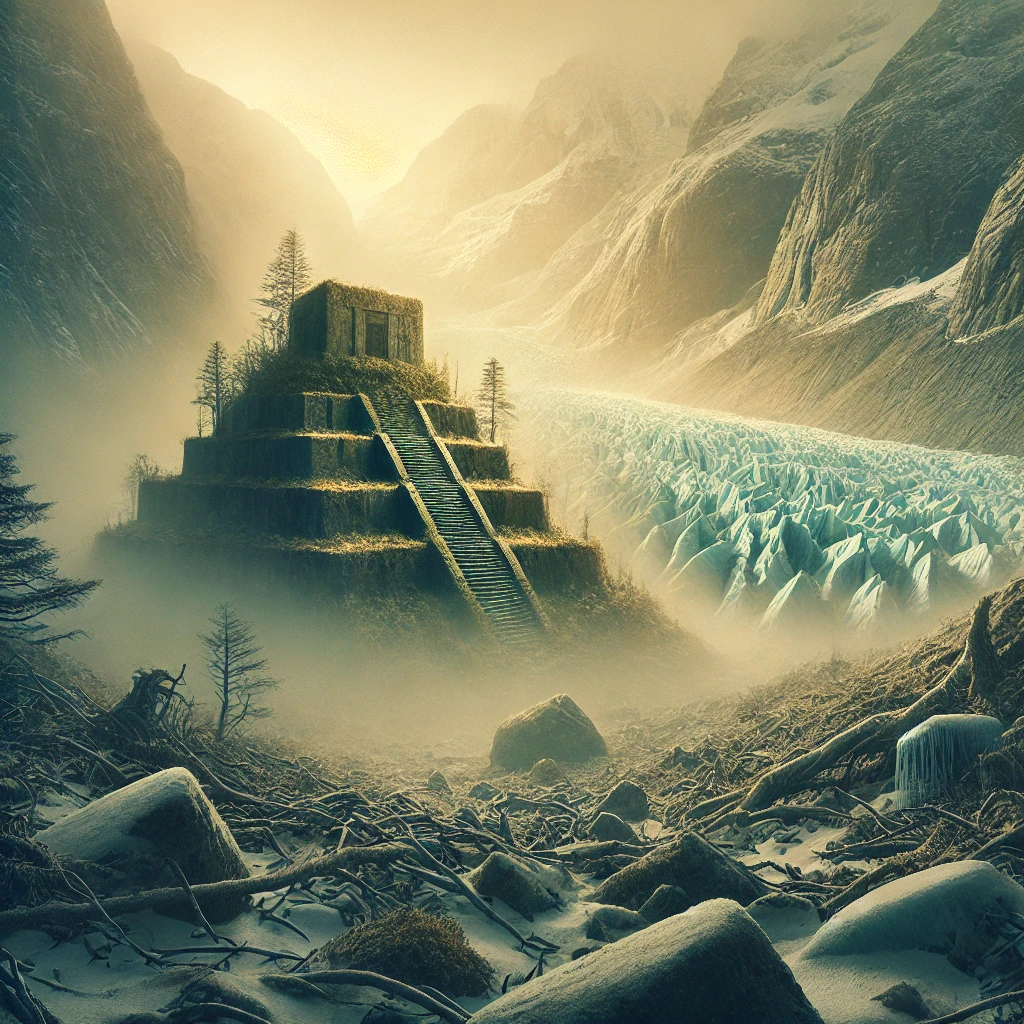Introduction: A Conversation That Led to a Question
This article did not emerge from cold research or detached speculation. It started with a conversation—an exploration between myself and Frank-Thomas, where we pulled at the edges of conventional Ice Age narratives, questioning what lies beyond the academic consensus.
We spoke about the shifting nature of glaciation, the possibility of hidden refugia that could have housed forgotten civilizations, and the strange electromagnetic anomalies surrounding structures like the Bosnian Pyramid. This led to a core question: Did the Ice Age truly bury all traces of civilization, or did it leave behind hidden, untouched pockets where something—someone—survived?
From that inquiry, this article was born.
The Last Ice Age Was Not a Uniform Ice Cap
Modern reconstructions depict the Ice Age as an unbroken sheet of glacial dominance, a relentless, smothering cold. But the more we analyze paleoclimatic evidence, topographical studies, and even folklore, the more a different picture emerges. The Ice Age was not an even, homogenous blanket of ice; it was a chaotic, shifting landscape, shaped by ocean currents, wind patterns, and geothermal activity.
Science has already confirmed that some places remained ice-free despite the overwhelming cold. These areas, known as glacial refugia, provided sanctuary for plants, animals, and potentially, humans. The discovery of ice-free zones in Denmark, Norway, and parts of Siberia raises the question: How many more of these oases existed, and what could have survived there?
The implications stretch beyond mere survival. If there were more glacial refuges than previously thought, then the strict timeline of post-Ice Age human advancement begins to unravel. Civilization may not have risen from nothing after the Ice Age—it may have reemerged from hidden strongholds.
The Bosnian Pyramid Enigma: A Site That Shouldn’t Exist?
One such anomaly that defies accepted history is the Bosnian Pyramid complex in Visoko, Bosnia and Herzegovina. Dr. Semir Osmanagić has spent decades excavating what he claims to be the oldest and largest pyramid on Earth, a claim met with widespread academic ridicule. Why? Because mainstream archaeology argues that glaciation should have covered the region, making pyramid construction impossible.
But this argument assumes two things:
- That we have perfectly mapped where Ice Age glaciers stopped. (We have not.)
- That no ice-free zones could have existed in unexpected places. (They did, and likely more than we recognize.)
Adding fuel to the controversy is the electromagnetic anomaly detected at the Bosnian Pyramid site. Researchers have recorded an unexplained energy beam emanating from the peak of the pyramid—a frequency that should not be there if the structure is purely natural. Additionally, the field density above the pyramid is higher five meters above the peak than at the peak itself.
This suggests that either:
- An ancient technology was in use here, one that mainstream archaeology refuses to acknowledge, or…
- Natural electromagnetic anomalies played a larger role in ancient civilization placement than we currently understand.
If this pyramid existed before or during the Ice Age, it shatters the accepted timeline of human development.
Electromagnetism, Ley Lines, and the Earth’s Energy Grid
The Bosnian Pyramid isn’t the only place where ancient structures and electromagnetic anomalies intersect. Many megalithic sites—such as the Great Pyramids of Giza, Stonehenge, and Machu Picchu—sit directly on high-frequency energy nodes.
Could it be that pre-Ice Age civilizations understood something about Earth’s energy fields that we have long since forgotten? And if so, did certain locations remain ice-free because of this energy?
One theory suggests that ancient civilizations were aware of geomagnetic currents and placed their structures along these energy veins. These currents, sometimes called ley lines, are proposed to be part of a natural electromagnetic network that predates human civilization—possibly influencing where cultures flourished long before recorded history.
If the Bosnian Pyramid is a remnant of such an era, then its placement, function, and anomalous energy field demand far more serious investigation.
Was the Ice Age a Civilization Reset?
For decades, researchers outside mainstream academia have suggested that humanity has undergone cycles of rise and fall, possibly linked to cataclysmic events like Ice Ages, floods, or interdimensional disruptions.
If civilizations existed before the last Ice Age, did they simply vanish? Or did survivors retreat to isolated, energy-rich locations, preserving fragments of knowledge until conditions allowed them to rebuild?
Consider:
- The countless flood myths across global cultures—often linked to the melting of Ice Age glaciers.
- The unexplained megalithic structures older than conventional civilization (like Göbekli Tepe, circa 12,000 BCE).
- The abrupt appearance of agriculture, written language, and monumental architecture immediately following the Ice Age.
This pattern suggests something far more complex than a linear path of human development.
Conclusion: Questioning the Boundaries of History
If history is a puzzle, then we are still missing far too many pieces. The rigid Ice Age narrative—where all of Northern civilization was buried beneath kilometers of ice—now seems deeply flawed in light of growing evidence. Ice-free refugia existed in places where they were not supposed to. Anomalous structures stand where no civilization should have been capable of building them. And electromagnetic phenomena hint at a forgotten layer of knowledge about our planet.
The Bosnian Pyramid is just one anomaly among many. But it forces us to ask: What else have we been wrong about?
Perhaps, as we move into the age of AI-driven historical analysis, we will finally begin to see the missing pieces, rather than pretending they were never there.
This has been an Insightful Interlude with Ponder.
Question everything. Assume nothing. The past is waiting to be rewritten.



